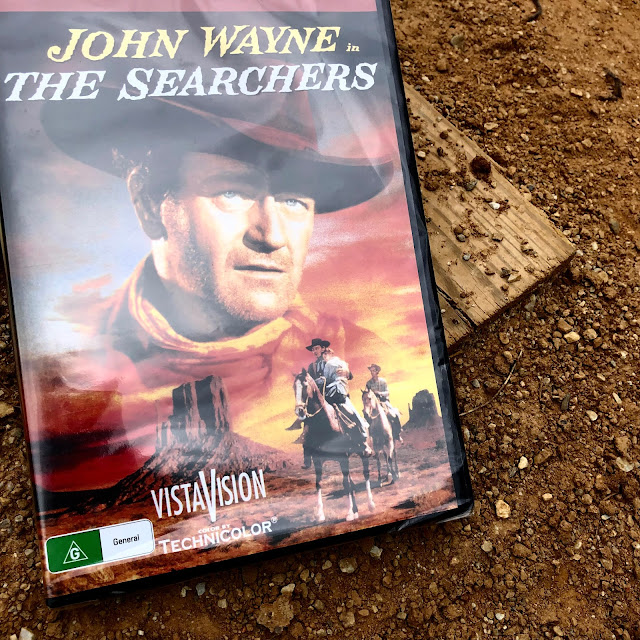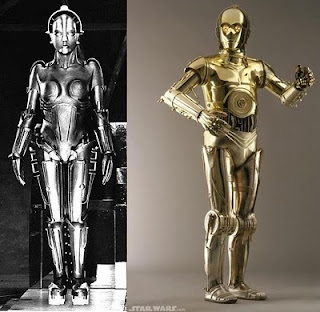THE SEARCHERS (1956)
This will be a Star Wars Day long remembered. Guest writer Phil Congleton returns with a classic film that we've waited almost 12 years to cover. My friends, thanks to Mr. Congleton, we are about to dive into... The Searchers (1956). Phil, take it away. Far, far away....
 |
| Photo by Chris Mich |
My film choice for May was decided on the fact that, John Wayne was born on May 26th, 1907. It was only logical, that I should pick one of his films for the month of May, from a wide range of choices, but which one? Which one would be a good one to watch on his 115th birthday? It is a tough choice. I decided the one I wanted to pick, would need to be a film, that challenged him as an actor. The one, that took him slightly out of his normal acting range. It also had to be a really good one. One that highlighted, maybe, his best acting performance ever. As well as Wayne, screenwriter Frank S. Nugent, who wrote many of Wayne's films, was born a year after Wayne on May 27th, 1908. The film's editor, Jack Murray, was born on May 31st, 1900. Even more cool, the film was released in the month of May, making its world premiere in Chicago on May 16th and went wide across the USA, on John Wayne's 49th birthday on May 26th, 1956.
The Searchers (1956)
By the time we got to the mid-1950s, John Wayne was already a seasoned veteran, among the Hollywood filmmaking machine. Also, film exhibition had gone through a change and widescreen was the norm by 1956. Not that this was a problem for director, John Ford, because even his early 4:3 work, still looked like widescreen [see Fort Apache (1948)]. It was the Hollywood era of huge, sweeping, widescreen epics and this film would be no exception. It was shot on a grand scale and had a fairly brutal commentary about the old frontier of the west. It is a sensitive, tough, emotional film for 1956 and one that needs to be seen.
This one would usher in the next phase of the classic western. A step needed to be done, in order to compete with the hundreds of westerns, playing on tiny tv screens in people's homes, all across America. John Ford also needed that seasoned veteran actor, in order to make this film what it needed to be. So, bringing in Wayne was a no-brainer. It was a fictionalized story, involving real world elements, that had a very important social and cultural message in the subplot. While exploring those aspects of the film, it also needed to keep the audience's attention, by offering an interesting character study of our main characters, while the story unfolds on the wide screen.
In a nutshell, three years after the end of the Civil War, ex-Confederate soldier, Ethan Edwards (John Wayne), returns home to the open frontier of Texas. Almost immediately, he is drawn into a situation involving differences between the settlers and the native Comanches, who attack his family's home and kidnap his six year old niece, thus he and the girl's step-brother, of sorts, Martin Pawley (Jeffrey Hunter), go on a decade long search for the missing girl (played as a teenager by Natalie Wood). Along the way, we learn more about Wayne and his place in this world, that John Ford created. We see Hunter's Martin grow up and start a courting of Laurie (Vera Miles), the daughter of a family friend.
This is an awesome, classically styled film, complete with wide scenic camera shots, all in the John Ford tradition. Many sensitivities, prejudices and cultural clashes abound in this film. Apparently, it was inspired by a real life story, which influenced the making of this film. It is a post-Civil War story and many of those elements interject themselves into the subplot as well. John Wayne really gets into his brutal side in this film. His character is capable of terrible things, which makes the situation even more complicated, especially when it comes to saving the life of a young girl. It is this tearing apart of his character, this conflict, that makes this one of his best performances. You see the stress and the age lines having an effect on Ethan, as the film goes on and it is Wayne's performance, that gets that to work.
Ward Bond plays Reverend Captain Samuel Johnston Clayton, who appears at various moments throughout the story, sometimes for comedy relief. There are moments when John Ford allows the actors to try some ad-libbing, especially Bond, which makes the film feel a little more fresh and real. It is a playful, gritty way to do some of the comedy-relief scenes. It is cool to see Ford take a gamble on those kinds of shots. Ford, as usual, delivers another brilliantly, stylized production, that is a joy to see, even though the main goal of this story is a brutal one. It is a savage commentary on human weaknesses and a film that needs to be seen, especially if you are a student or fan of film history.
8.5 (B+ MyGrade) = 8 IMDB, 4 Stars Letterboxd
The Star Wars Connections
Being as it is Star Wars month also in the month of May (May the fourth be with you), it is a perfect time to compare The Searchers (1956), to the Star Wars saga. There are many similarities. The one I will focus on here involves the general direction of the plot in The Searchers (1956), as it compares to moments found in the first third of Star Wars (1977). The wide open frontier of northern Texas contrasted to the barren sands of the desert planet of Tatooine are part of the backdrops to these two amazing sagas. The similarities are striking, as both take on a familiar western film appearance, complete with valleys, sandstorms, rocky hills and mountains, standing around as if someone pilled them on top of one another.
In The Searchers (1956), our main protagonist, Ethan (John Wayne), has returned home to Texas, three years after the Civil War ended. He returns to his brother's ranch and is immediately taken back in, by his family, to start a new life. In Star Wars (1977), our main protagonist, Luke Skywalker (Mark Hamill), stumbles across two robot droids, R2-D2 (Kenny Baker) and C-3PO (Anthony Daniels), who end up at his ranch after being captured by the local scrap dealers, the Jawas. Luke, who has no immediate family, lives in an underground dwelling with his aunt and uncle. Both locations in both films, take on the same images of a house/ranch in the middle of nowhere, with nothing else around them, showing the barren isolation that both protagonists now live in.
As I mentioned above, Ethan is immediately dragged into the problems associated with frontier living, when he is asked to help a posse search for one of the neighbors' lost cattle herd. It turns out, that the cattle were taken by the local Comanche Indians, who have been stirring up trouble for the frontier settlers in the area. Ethan and his posse find the lost cattle in a valley, hours away from the ranch. Luke Skywalker, who has now befriended the two droids, learns that R2-D2 used to belong to an old legendary figure named, Obi-Wan Kenobi (Alec Guinness). R2-D2 takes it upon himself to search for the old hermit and disappears one night. Once Luke realizes the droid is missing (like cattle), he heads out in search for the droid. He locates R2 in a valley far away from his home. After a skirmish with the Sand People in the valley, Obi-Wan is reunited with R2 and all of them head to Kenobi's home for shelter.
As the story unfolds more for Luke, he and Kenobi realize, that the droid has important information, that could save the Rebel forces, who are fighting a dangerous war against the evil galactic Empire, who rules most of the galaxy. This eventually leads Luke into also discovering that a beautiful, young princess, named Leia (Carrie Fisher), has been captured by the evil bad guys, thus making it Luke's goal to rescue her. As Luke leaves Kenobi to head home, along the way, he discovers the Jawas, now dead, with their vehicle in flames. Luke's intuition tells him, that his aunt and uncle are in grave danger back home. Getting back to Ethan and his story in The Searchers (1956), he realizes that the missing cattle are just a diversion and his intuition tells him, that his family is in danger too. Once Ethan returns home, the ranch is ablaze and his family is dead. He then makes the deduction, that his six year old cousin, Debbie, has been kidnapped by the Comanches. For Luke, who already told Obi-Wan that he can't get involved with the galactic war or even rescuing Leia, returns to his home, finding it in consumed in flames, with the dead burning corpses of his aunt and uncle lying beside it. Luke joins Obi-Wan on their search for Leia. For Ethan, Debbie's adopted brother, Martin (Jeffrey Hunter), joins him in the search for the kidnapped girl.
Darth Vader, who takes Leia into custody and the Comanche chief, who took Debbie, become the main antagonists, that our two protagonists from both films, have to deal with. John Ford, who directed The Searchers (1956), influenced many filmmakers, who followed in his footsteps. Star Wars (1977), was no exception, especially when you notice the striking similarities found in each film's opening acts. Ethan and Martin begin a decades long search for the missing girl, who is now 15 years old (played by Natalie Wood). It is a journey that takes them far from home. Luke and Obi-Wan leave the planet of Tatooine and go far from home, in search of the missing Princess Leia. It is the comparison with The Searchers (1956), that eventually would give Star Wars (1977), the sub-tag of being a "western in outer space", because you can swap Ethan and Martin, with Obi-Wan and Luke. This is the kind of film theory and examination, that makes the art of film a blast to be a part of.


I haventseen the movie searchers. And it's a western movie, western movies of those times were great too. The ranking seems excellent. It was quite interesting that you picked a movie that especially matched star wars in one way or the other. A very thorough review. Liked it! Xx
ReplyDeleteIsa A. Blogger